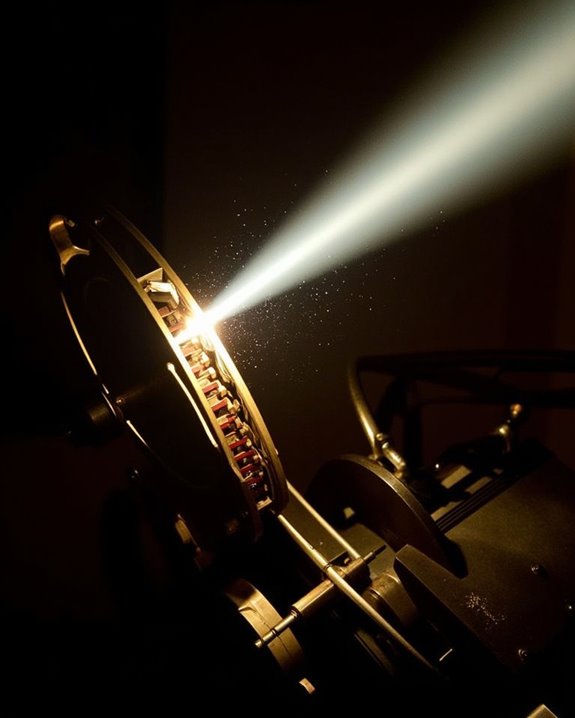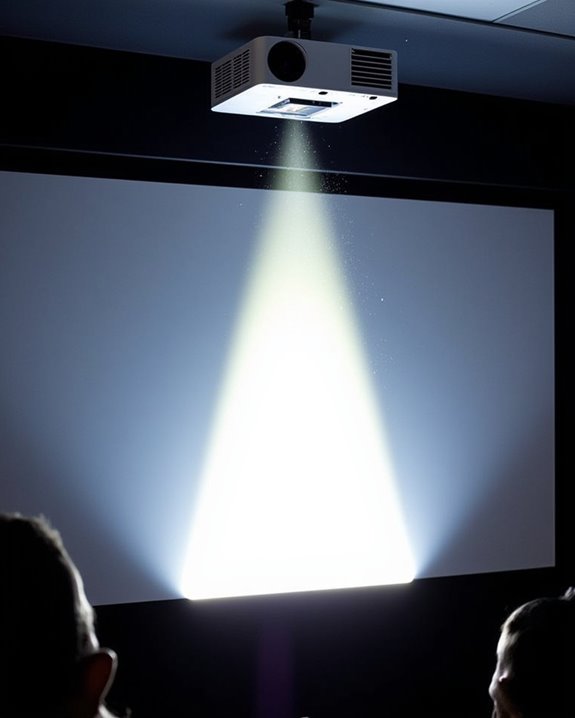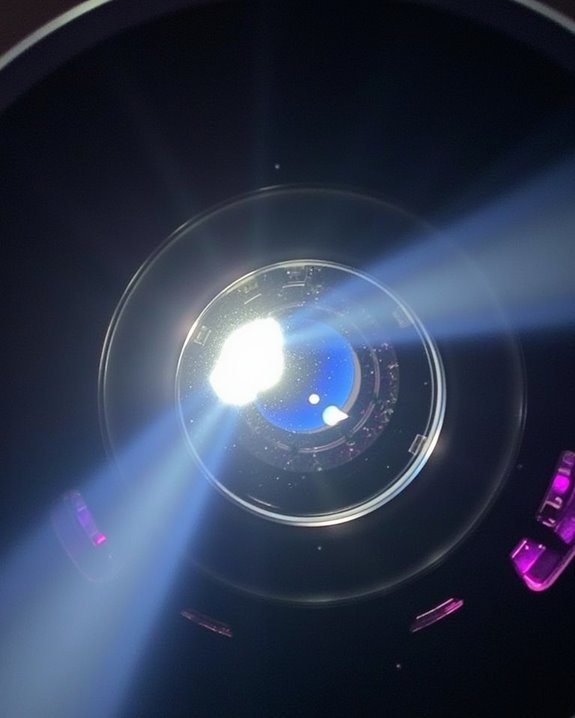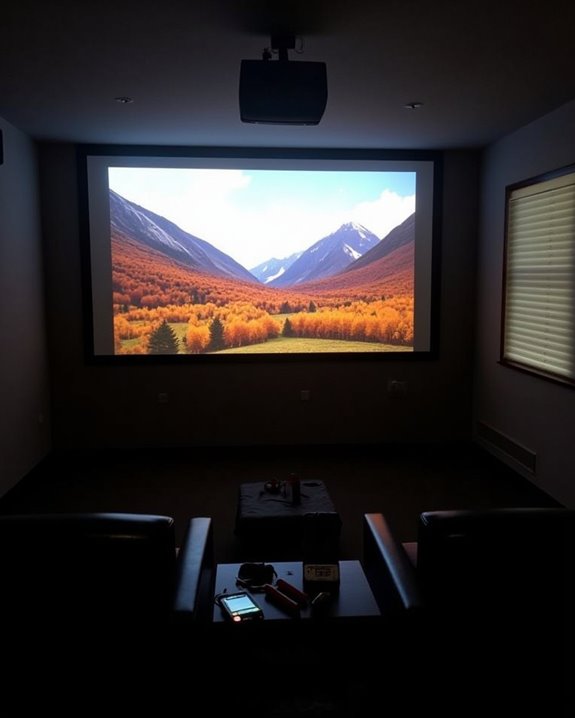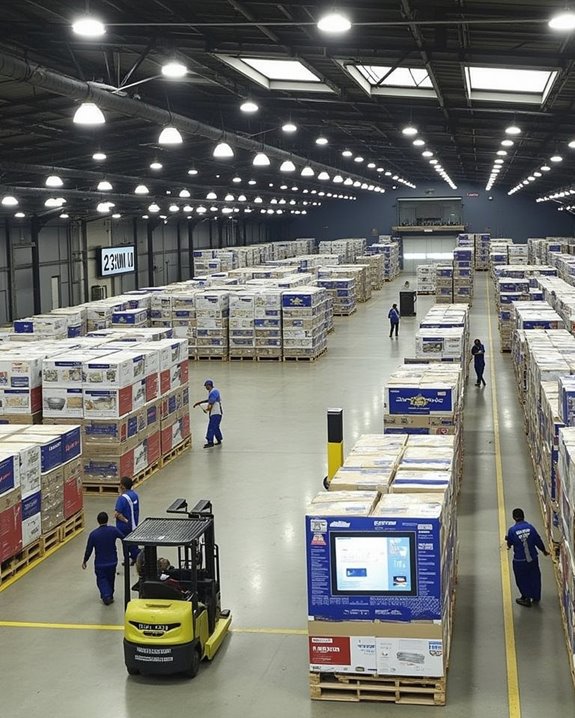While digital projection now dominates 98% of movie theaters worldwide, the mechanical magic of traditional film projectors once defined the cinematic experience for generations. You’ve likely watched films without considering the intricate system working behind you—a precision dance of sprockets, shutters, and light that transforms static images into seamless motion. These mechanical marvels represent a blend of optical science and industrial engineering that revolutionized entertainment. The technological ingenuity behind these devices reveals how we created the illusion of movement long before computers entered the picture.
Key Takeaways
- Film projectors run at 24 frames per second, using intermittent motion systems to advance film frame-by-frame.
- Light from a xenon or carbon arc lamp passes through the film and is magnified by lenses onto the screen.
- A rotating shutter blocks light during frame advancement, preventing blur and creating the illusion of continuous motion.
- Multiple film reels are managed through visual cue marks or platter systems that allow continuous playback.
- Projectionists must carefully thread film, maintain proper tension, synchronize audio, and perform regular equipment checks.
The Mechanics Behind Film Transport and Advancement
While modern movie theaters have mostly switched to digital projection, the mechanical marvels of traditional film projectors represent a fascinating blend of precision engineering and optical science. These devices transport film through a carefully choreographed system of gears, sprockets, and pull-down mechanisms that create the illusion of continuous motion from still frames.
You’ll find that film reel management involves unwinding from platters through payout units that control rotation speed, with projectionists often needing to rewind unreceived reels before use. The intermittent motion system advances film frame-by-frame using a pull-down claw or shuttle mechanism, holding each frame briefly for projection. Sound synchronization, once a challenge in early systems, evolved through mechanical synchronization methods that coordinate the worm screw mechanism with sprocket teeth to maintain perfect timing. Modern projection technology, such as the hybrid LED-laser light source, has significantly extended lifespan and reduced maintenance in comparison to traditional film projectors.
Inside the Projection System: Light, Lenses, and Shutters
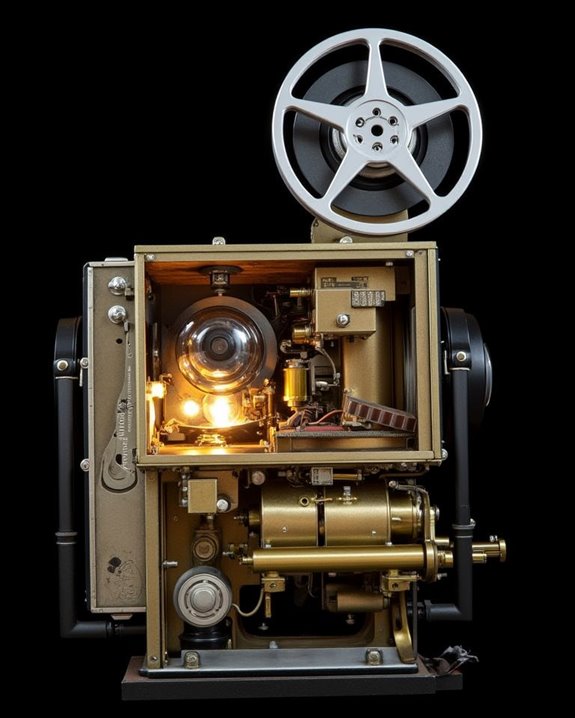
At the heart of every film projector lies a sophisticated optical system that transforms a strip of film into the moving images we enjoy on screen. This system combines three critical elements working in perfect harmony: light sources, precisely calibrated lenses, and synchronized shutters.
The light source—typically a xenon or carbon arc lamp—generates intense illumination that passes through a condenser lens, concentrating light onto the film frame. Proper lens calibration is essential for image clarity, with the imaging lens focusing the illuminated frame onto the screen. Meanwhile, the shutter mechanism, rotating in sync with the film advancement, blocks light during frame transitions to prevent visible flicker. This creates the illusion of continuous motion at 24 frames per second while specialized cooling systems prevent overheating, ensuring both performance and safety. Modern projectors also utilize LED bulbs that last significantly longer and provide energy-efficient illumination.
The Art of the Changeover: Managing Multiple Reels
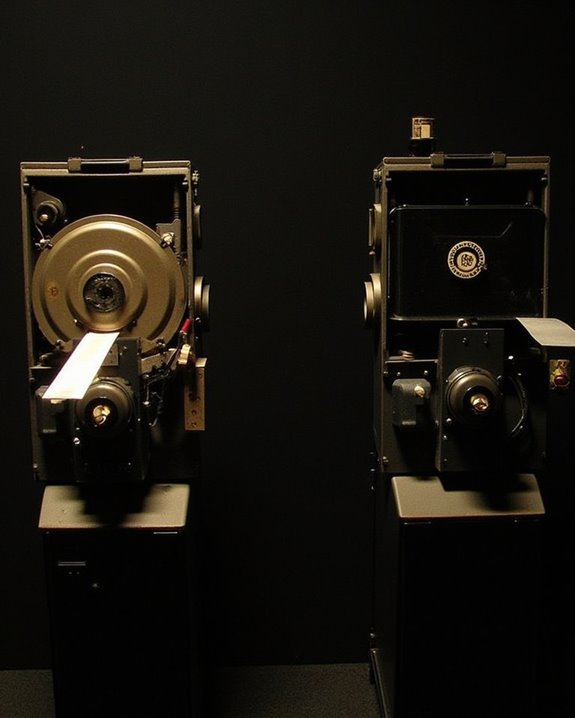
The operation of a movie projector extends beyond the optical system to the practical challenge of showing feature-length films that won’t fit on a single reel. Projectionists developed specialized techniques for smooth progressions between reels, often relying on visual cue marks that appear in the upper right corner of the frame. These marks, appearing twelve feet before the reel’s end, signal when to start the next projector.
Proper reel handling is essential to this process, with projectionists needing to load, align, and cue each reel precisely. The changeover must occur within one second after the final cue, requiring vigilant attention. Later innovations like platter systems eliminated the need for changeovers by splicing multiple reels together, allowing continuous playback without manual intervention and reducing both labor costs and wear on prints. Efficient setup and seamless transitions were critical to maintaining an uninterrupted viewing experience, much like how modern quick-setup projector screens enable rapid and smooth outdoor movie presentations.
From Film to Screen: How Images Become Moving Pictures
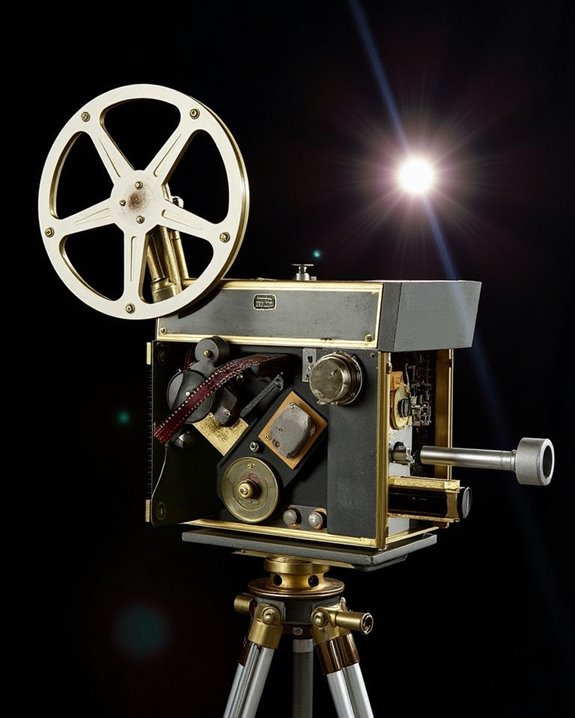
Before you’ll see a motion picture come to life on the big screen, it must undergo a fascinating mechanical process that transforms still images into fluid movement. At the heart of this system, film containing 24 frames per second passes through a precisely timed intermittent transport mechanism, pausing briefly as light shines through each frame. The projector’s rotating shutter blocks light during frame advancement, preventing blur while creating the illusion of continuous motion.
Unlike today’s digital conversion and digital playback systems, traditional projectors rely on optical principles and mechanical precision. Light from a powerful lamp passes through the stationary film frame, then through focusing lenses that magnify the image onto the screen. This complex dance of film, light, and optics exploits persistence of vision, allowing your brain to perceive separate still images as seamless motion.
The Projectionist’s Craft: Skills and Techniques
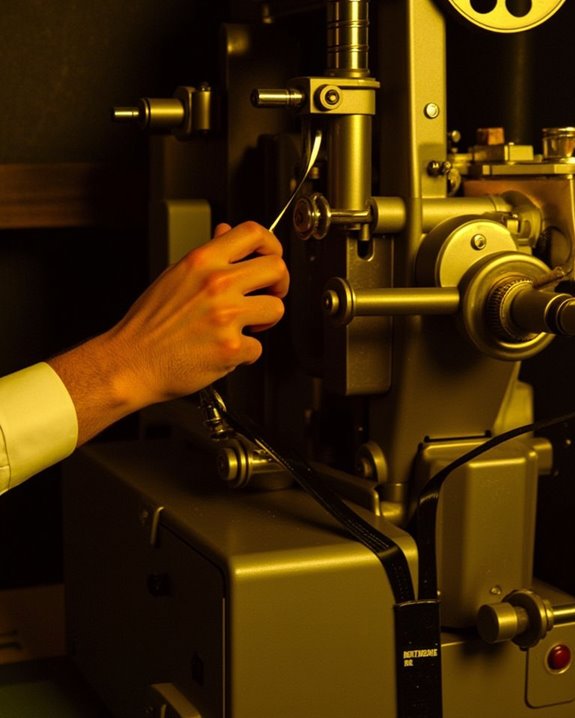
Behind every successful film screening stands a skilled projectionist whose craft extends far beyond simply pressing a play button. The projectionist meticulously threads film through complex mechanisms, ensuring proper tension and alignment while synchronizing audio with visuals for ideal audience engagement. They must master both traditional film handling and digital integration, adapting their techniques as technology evolves.
When you attend a theater, you’re experiencing the results of precise quality control, where projectionists continuously monitor image clarity, sound levels, and timing. Their critical thinking skills come into play during inevitable technical challenges, requiring quick problem-solving to maintain the illusion of seamless entertainment. Pre-show checks include inspecting film for damage, calibrating projection lamps, and programming automation systems that control lighting transitions—all essential elements of this specialized craft that bridges technical expertise with artistic presentation.
Frequently Asked Questions
How Hot Do Film Projector Bulbs Get During Operation?
Just as you seek illumination, film projector light bulb temperatures reach extremely hot levels—xenon lamps hit several hundred degrees Celsius. You’ll find heat dissipation methods like cooling fans are essential for maintaining bulb longevity.
Can Old Film Projectors Be Modified for Home Theater Use?
Yes, you can modify old film projectors for home theater use. With quieter fans, proper mounting, and safety upgrades, your film modification project can create a unique theater experience that preserves vintage charm.
What Safety Hazards Were Common With Vintage Film Projectors?
Like playing with fire, vintage projectors presented serious hazards. You’d face film reel safety risks from flammable nitrate stock, mechanical injuries from moving parts, and electric shocks without proper projector maintenance procedures.
How Were Film Breaks Repaired During a Screening?
You’d quickly stop the projector, cut damaged sections, apply cement or tape to join ends, and align perforations. Quick film reel repair was a essential projectionist skill, performed in dim light during screenings.
Did Projectionists Develop Physical Ailments From Repetitive Projection Tasks?
While your audience sees magic, you’re battling projectionist fatigue. Yes, you’d commonly develop repetitive strain injuries from threading film, adjusting focus, and handling heavy reels in cramped booths for hours on end.

